Thanks to everyone that have been passing along their pest sightings.
If you’d like a refresher you can always refer back to previous reports, as potato leaf hopper reports have been coming in, basil downy mildew has been identified in a couple locations in the state, and folks have been finding three-lined potato beetles and their larvae.
In this edition: two growers reported common stalk borer, and growers are also reporting hornworm moths flying a week or more ago, meaning the caterpillars are likely out and feeding. Cucurbit powdery mildew and downy mildew are also discussed as they have both been found in Massachusetts.
On the positive side of things, I’ve also been hearing about folks finding big healthy monarch caterpillars.
Cucurbit Downy Mildew
Hornworms
Powdery Mildew
Common Stalk Borer
CUCURBIT DOWNY MILDEW
Cucurbit downy mildew has been verified in cucumbers on Cape Cod, which is a surprising jump from the closest known previous report (New Jersey). Because of prevailing west- to-east weather patterns, there is a chance that this incidence of disease will not easily spread to us here in Maine, but it can be very destructive if conditions are favorable to it. Like cucurbit powdery mildew, this disease does not overwinter here, and its severity in any given season is often dependent upon when it arrives, if at all.
The first noticed symptoms of cucurbit downy mildew are often angular yellow leaf spots, which are angular because they are constrained by leaf veins. Corresponding dark lesions, and sometimes spores, are seen on bottom of the leaf as the disease develops. Meg McGrath’s website at Cornell has lots of photos to compare with here.
The best “control” is to choose resistant varieties, when available. Some strains of the disease have overcome resistance in older cucumber varieties, but new varieties have been developed, and ‘NY 264’ and ‘Bristol’ have been promising in trials in Long Island and at the University of Massachusetts.
Materials for controlling fungi, and fungi-like diseases like downy mildew, are most effective when applied pre-emptively, so watching for the spread of the disease is important.
Scouting should start in earnest when the disease has been reported nearby.
For farm-scale control options, consider a bio-fungicide like DoubleNickel and/or a copper product like Kocide 3000-O as described in the New England Vegetable Management Guide.
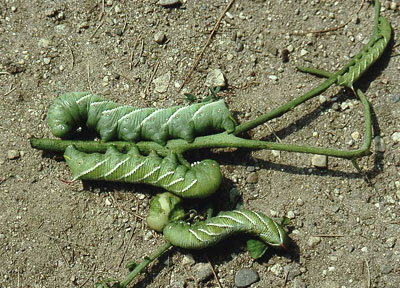 |
| Hornworms on tomato |
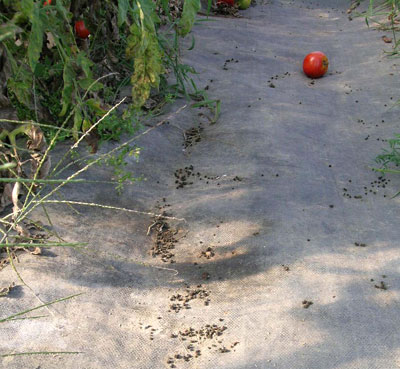 |
| Hornworm frass below tomato plants |
HORNWORMS
by Eric Sideman
Hornworms are probably the most destructive insect attacking tomatoes and they are showing up now. They are giant caterpillars that can do a vast amount of eating in a very short time. Right now you may find young, tiny ones. Sometimes it seems that over night healthy looking tomato or pepper plants are stripped of their leaves leaving bare stems. The hornworms will also attack the fruit, eating gouges out so large that they look more like bites of a furry animal than an insect.
Look now for the damage and the frass, which is black pellets laying all around plants hosting hornworms. The frass may be your first sign there is a problem. The frass of young hornworms is small. I don’t bother looking for the caterpillar because they blend in so well – I just look for the frass.
The adults are large, fast flying hawk moths, which in flight may look like a hummingbird. At dusk they hover over flowers sucking nectar. Eggs are laid on tomato leaves and hatch in 5 days.
Hand picking is a bit frightening but does work and chickens enjoy fighting with the challenging pest. The problem with hand picking is that they blend in very well and it is easy to overlook one or two caterpillars, which can do significant damage in a day or two. I got a report from a grower who is using a black light at night and finding the worm shining.
Bt works very well on this caterpillar.
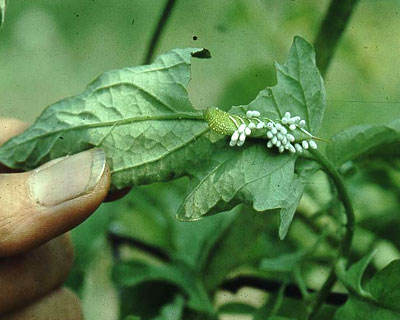 |
| Tomato hornworm hosting braconid wasp cocoons. Vern Grubinger photo |
What are those white things on tomato hornworms?
Tomato hornworm larvae are parasitized by a number of insects. One of the most common is a small braconid wasp, Cotesia congregatus. Larvae that hatch from wasp eggs laid on the hornworm feed on the inside of the hornworm until the wasp is ready to pupate. The cocoons appear as many small white projections protruding from the hornworm’s body. Parasitized hornworms should be left in the field to conserve the beneficial parasitoids. The wasps will kill the hornworms when they emerge from the cocoons, and will seek out other hornworms to parasitize.
POWDERY MILDEW
By Eric Sideman
Powdery mildew is a common disease of pumpkins and winter squash. All cucurbits are potential hosts, but many common cucumber and melon varieties are resistant. The disease can cause infected leaves to die prematurely, reducing yields and lowering fruit quality, especially taste. Winter squash from diseased plants won’t store as long as fruits from healthy plants. The fungus that causes the disease does not overwinter in Maine. Spores blow up every year from southern overwintering sites. If they arrive late in the season, you may not need any control; but if they arrive in early to midsummer, exercise some control or you may have no leaves by mid-August, and worse yet – bland, starchy squash.
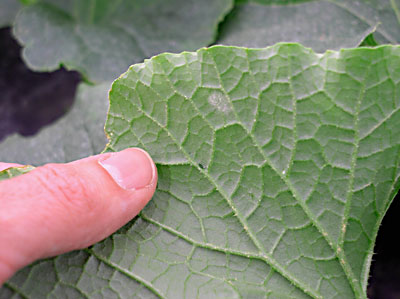 |
| First signs of powdery mildew |
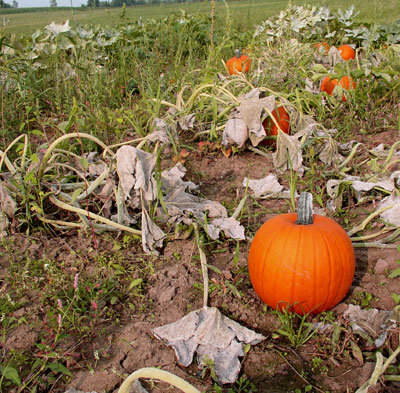 |
| Thorough infection of powdery mildew late in the season |
I have not seen any yet. Go out and scout. Check upper and lower surfaces of leaves of older plants every few days starting now. The first symptoms are usually white, powdery fungal patches on the undersides of older leaves. Yellow spots may form opposite these, on the upper leaf surfaces.
No products with systemic activity (products that move through the plant) are approved for organic production, and applying fungicide to the lower leaf surface is difficult. In experiments, foliar applications of sulfur have been more effective than most other organic products for powdery mildew, apparently because sulfur deposited on the upper leaf surface can volatilize and be redistributed to the lower surface. Sulfur can be phytotoxic, especially if applied when temperatures are hot. Mineral oil (JMS Stylet is one) has also been effective, but can aggravate sulfur phytotoxicity if the two products are used too closely together in time, so follow all label instructions carefully, particularly if rotating between these two materials.
There are some products made from potassium bicarbonate (Kaligreen and Milstop are two of these) that have shown good efficacy in the past. Combinations of mineral oil and a potassium bicarbonate have shown better efficacy than either alone.
For a good discussion of these, including efficacy, see the second edition of the Resource Guide to Organic Insect and Disease Management
COMMON STALK BORER
Despite its name, I don’t hear many reports of the common stalk borer (Papaipema nebris). This pest doesn’t come up in conversation in the Northeast very often.
While most commonly a pest of corn, it isn’t a specialist, and can be found boring into other plants, including vegetables or hemp. The caterpillar burrows into the stem, and can make the plant appear wilted or deformed. The caterpillar itself is easily identifiable, with a brownish to purple color, white lines running down the length of its body, and an obvious “saddle”, interrupting the white lines, about 1/4 the length of its body, closer to the head than the tail.
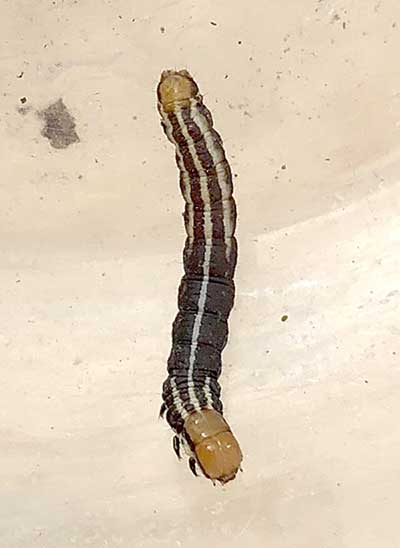 |
| Common stalk borer. Photo Casey Robison |
The stalk borer only has one generation per year. Moths typically fly at night, and lay up to 2000 eggs in grasses or ro led up leaves, in late summer or early fall. Eggs hatch the following spring, and the caterpillars burrow into the closest stem, typically a grass or other broadleaf weed. By summer they have out-grown their initial host plant, and that’s when they may move into crops, seeking protection in a larger plant stem.
Damage is most likely to be on field edges, where caterpillars move into the crop after leaving the grasses or weeds they initially inhabited. Controlling populations would be difficult after they have burrowed into the protection of a stem, so best practices for management are to keep field edges mowed starting in mid-August when adult moths are looking for egg- laying sites, and in the early spring before eggs hatch. Mowing after eggs have hatched could cause more trouble as any surviving caterpillars may then simply seek refuge in your crop sooner than they otherwise would have.
Information sourced, in large part, from fact sheet by A. Genetzky, E.C. Burkness and W.D. Hutchison
